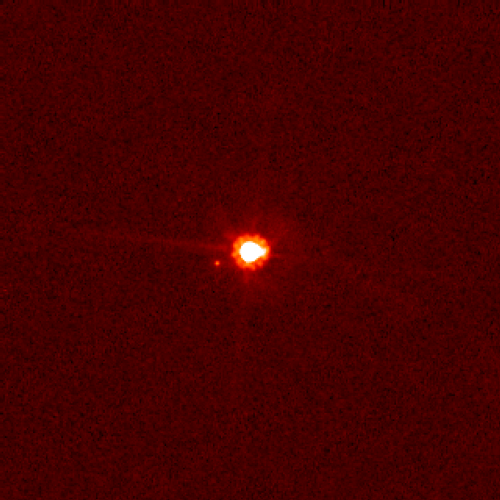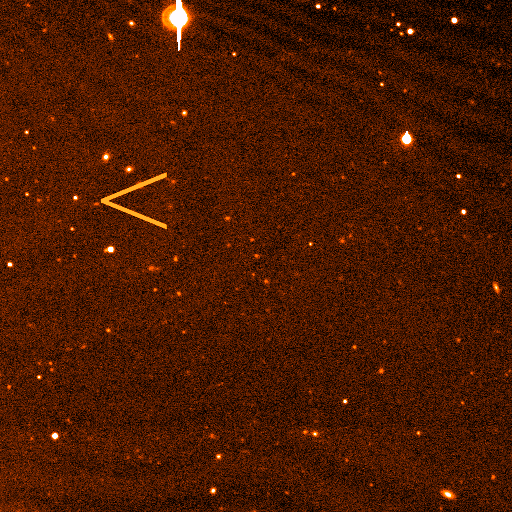🎃👻☠️ Skull Seen In Small Asteroid… Spooky As It Gets! 🎃👻☠️

🎃👻☠️ Skull Seen In Small Asteroid… Spooky As It Gets! 🎃👻☠️
2015 TB145 - 2000 foot wide asteroid.
🎃 Part Of Spinning Blue Ball’s Five Days of Halloween!! 🎃
More Posts from Astrosciencechick and Others
Hubble in Safe Mode as Gyro Issues are Diagnosed
NASA - Hubble Space Telescope patch. Oct. 8, 2018 NASA is working to resume science operations of the Hubble Space Telescope after the spacecraft entered safe mode on Friday, October 5, shortly after 6:00 p.m. EDT. Hubble’s instruments still are fully operational and are expected to produce excellent science for years to come. Hubble entered safe mode after one of the three gyroscopes (gyros) actively being used to point and steady the telescope failed. Safe mode puts the telescope into a stable configuration until ground control can correct the issue and return the mission to normal operation. Built with multiple redundancies, Hubble had six new gyros installed during Servicing Mission-4 in 2009. Hubble usually uses three gyros at a time for maximum efficiency, but can continue to make scientific observations with just one. The gyro that failed had been exhibiting end-of-life behavior for approximately a year, and its failure was not unexpected; two other gyros of the same type had already failed. The remaining three gyros available for use are technically enhanced and therefore expected to have significantly longer operational lives.
NASA’s Hubble Space Telescope. Image Credit: NASA
Two of those enhanced gyros are currently running. Upon powering on the third enhanced gyro that had been held in reserve, analysis of spacecraft telemetry indicated that it was not performing at the level required for operations. As a result, Hubble remains in safe mode. Staff at NASA’s Goddard Space Flight Center and the Space Telescope Science Institute are currently performing analyses and tests to determine what options are available to recover the gyro to operational performance. Science operations with Hubble have been suspended while NASA investigates the anomaly. An Anomaly Review Board, including experts from the Hubble team and industry familiar with the design and performance of this type of gyro, is being formed to investigate this issue and develop the recovery plan. If the outcome of this investigation results in recovery of the malfunctioning gyro, Hubble will resume science operations in its standard three-gyro configuration. If the outcome indicates that the gyro is not usable, Hubble will resume science operations in an already defined “reduced-gyro” mode that uses only one gyro. While reduced-gyro mode offers less sky coverage at any particular time, there is relatively limited impact on the overall scientific capabilities. For more information about Hubble, visit: https://www.nasa.gov/hubble Image (mentioned), Text, Credits: NASA/Sarah Loff/Felicia Chou. Greetings, Orbiter.ch Full article
Dust, stars, and cosmic rays swirling around Comet 67P/Churyumov–Gerasimenko, captured by the Rosetta probe. (Source)
math problem: *begins with “we know that..”*
me: WE dont know SHIT
This image is beautiful, and closer to my heart because I have done a field study at NRAO. Such an incredible experience!

The W50 supernova remnant in radio (green) against the infrared background of stars and dust (red).
Credit: NRAO/AUI/NSF, K. Golap, M. Goss; NASA’s Wide Field Survey Explorer (WISE).

My condolences to the people of France.
Terrorism has once again shown it is prepared deliberately to stop at nothing in creating human victims. An end must be put to this. As never before, it is vital to unite forces of the entire world community against terror.
I believe that the world will know the blessing of peace only when the love for power is overthrown by the power of love.
To all the people of France, may the force be with you during these tough vicious times.

PC: shirtshovel

NGC 2736: The Pencil Nebula
Image Credit: Howard Hedlund & Dave Jurasevich, Las Campanas Obs.


Eris is the most massive and second-largest dwarf planet in the known Solar System. Eris was discovered in January 2005 by a Palomar Observatory-based team led by Mike Brown, and its identity was verified later that year. In September 2006 it was named after Eris, the Greek goddess of strife and discord. Eris is the ninth most massive object directly orbiting the Sun, and the 16th most massive overall, because seven moons are more massive than all known dwarf planets.
Eris is a trans-Neptunian object (TNO) and a member of a high-eccentricity population known as the scattered disk. It has one known moon, Dysnomia. (Eris and Dysnomia are seen in the first image).
source

Facing NGC 3344 : From our vantage point in the Milky Way Galaxy, we see NGC 3344 face-on. Nearly 40,000 light-years across, the big, beautiful spiral galaxy is located just 20 million light-years away in the constellation of Leo Minor. This multi-color Hubble Space Telescope close-up of NGC 3344 includes remarkable details from near infrared to ultraviolet wavelengths. The frame extends some 15,000 light-years across the spiral’s central regions. From the core outward, the galaxy’s colors change from the yellowish light of old stars in the center to young blue star clusters and reddish star forming regions along the loose, fragmented spiral arms. Of course, the bright stars with a spiky appearance are in front of NGC 3344 and lie well within our own Milky Way. via NASA
I’ve been seeing some of the studyblrs that I follow are doing the 100 days of productivity challenge, and I’m considering attempting this. As a non-traditional, upper level university student, I’m trying to keep my life together by finding balance with school and family.
My kids got sick the first week of school, which carried on into the second week and I’ve been trying to catch up on the assignments I’m behind in (which is now down to half of my classes).
Have any of you guys done this challenge? What are the pros and cons from your experience?

NGC 7380, Wizard in Cepheus
-
 darkforestwizard reblogged this · 6 years ago
darkforestwizard reblogged this · 6 years ago -
 iadmiregurls liked this · 6 years ago
iadmiregurls liked this · 6 years ago -
 famousenemylover liked this · 6 years ago
famousenemylover liked this · 6 years ago -
 ecto-biologist-413 liked this · 6 years ago
ecto-biologist-413 liked this · 6 years ago -
 sxd-daes liked this · 6 years ago
sxd-daes liked this · 6 years ago -
 coolporygons liked this · 6 years ago
coolporygons liked this · 6 years ago -
 shinyartisanmongerbanana-blog liked this · 6 years ago
shinyartisanmongerbanana-blog liked this · 6 years ago -
 friendly-vampire-girl liked this · 6 years ago
friendly-vampire-girl liked this · 6 years ago -
 mycatarwen liked this · 6 years ago
mycatarwen liked this · 6 years ago -
 coldclawer liked this · 6 years ago
coldclawer liked this · 6 years ago -
 starsmain liked this · 6 years ago
starsmain liked this · 6 years ago -
 quantum-mecha reblogged this · 6 years ago
quantum-mecha reblogged this · 6 years ago -
 spacecaptainkirby reblogged this · 6 years ago
spacecaptainkirby reblogged this · 6 years ago -
 spacecaptainkirby liked this · 6 years ago
spacecaptainkirby liked this · 6 years ago -
 astrosciencechick reblogged this · 6 years ago
astrosciencechick reblogged this · 6 years ago -
 astrosciencechick liked this · 6 years ago
astrosciencechick liked this · 6 years ago -
 annaisaneek liked this · 6 years ago
annaisaneek liked this · 6 years ago -
 pocketful-of-kazoos reblogged this · 6 years ago
pocketful-of-kazoos reblogged this · 6 years ago -
 knoxx89 liked this · 6 years ago
knoxx89 liked this · 6 years ago -
 guacamole-kittens reblogged this · 6 years ago
guacamole-kittens reblogged this · 6 years ago -
 guacamole-kittens liked this · 6 years ago
guacamole-kittens liked this · 6 years ago -
 babyangeldog liked this · 6 years ago
babyangeldog liked this · 6 years ago -
 the-bat-and-the-joker reblogged this · 6 years ago
the-bat-and-the-joker reblogged this · 6 years ago -
 quantum-mecha liked this · 6 years ago
quantum-mecha liked this · 6 years ago -
 monamelissa liked this · 6 years ago
monamelissa liked this · 6 years ago -
 our-o-boros reblogged this · 6 years ago
our-o-boros reblogged this · 6 years ago -
 our-o-boros liked this · 6 years ago
our-o-boros liked this · 6 years ago -
 galactic-zoo reblogged this · 6 years ago
galactic-zoo reblogged this · 6 years ago -
 mackerelshark liked this · 6 years ago
mackerelshark liked this · 6 years ago -
 goodwilltoallpeople reblogged this · 6 years ago
goodwilltoallpeople reblogged this · 6 years ago -
 cyberneticdhampir liked this · 6 years ago
cyberneticdhampir liked this · 6 years ago -
 exalted-stardust reblogged this · 6 years ago
exalted-stardust reblogged this · 6 years ago -
 emmyseal liked this · 6 years ago
emmyseal liked this · 6 years ago -
 libraryinmyhead liked this · 6 years ago
libraryinmyhead liked this · 6 years ago -
 gi-ie-ru liked this · 6 years ago
gi-ie-ru liked this · 6 years ago -
 astronomer-matt-blog reblogged this · 6 years ago
astronomer-matt-blog reblogged this · 6 years ago -
 astronomer-matt-blog reblogged this · 6 years ago
astronomer-matt-blog reblogged this · 6 years ago -
 glacialdrip reblogged this · 6 years ago
glacialdrip reblogged this · 6 years ago -
 glacialdrip liked this · 6 years ago
glacialdrip liked this · 6 years ago -
 sharkspaceengine liked this · 6 years ago
sharkspaceengine liked this · 6 years ago -
 leemeibo liked this · 6 years ago
leemeibo liked this · 6 years ago -
 spinningblueball reblogged this · 6 years ago
spinningblueball reblogged this · 6 years ago